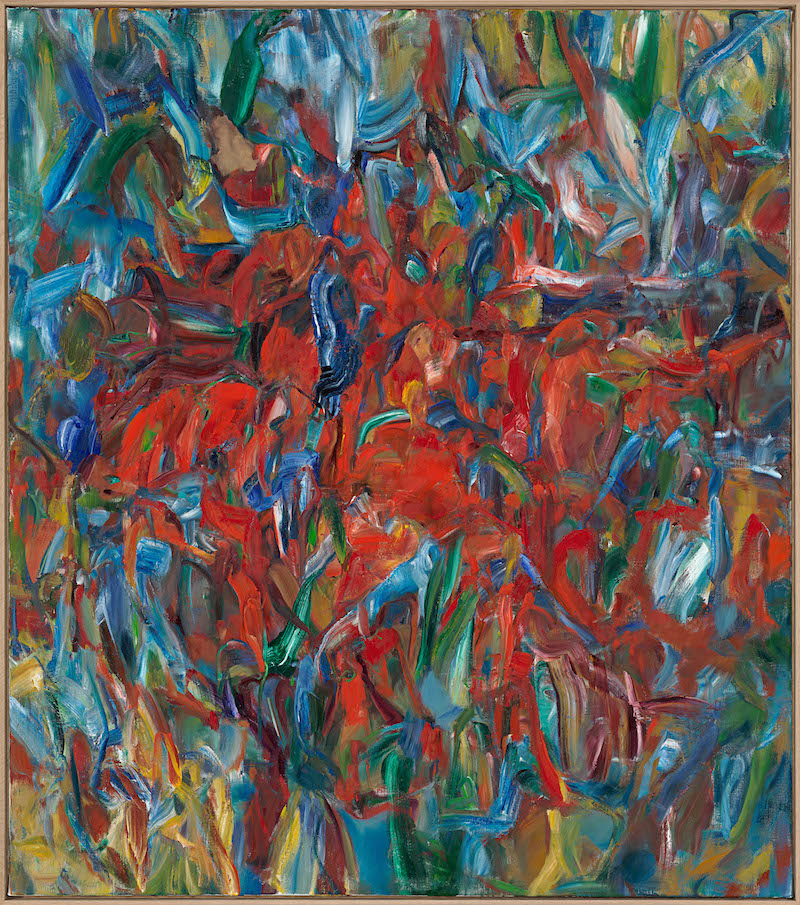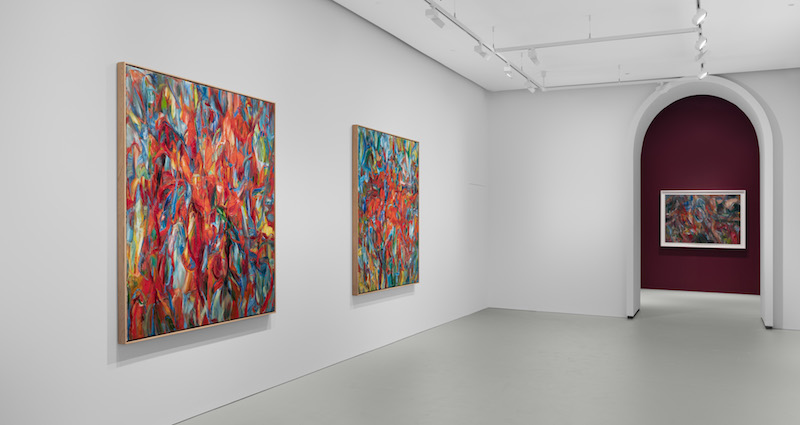Sabine Moritz was born in East Germany in 1969: her family managed to move west in 1985, but her early work often took its subjects from recollections of the Soviet era, and she remains engaged in exploring memory and its interpretations. Now she is presenting a series of new paintings across both Pilar Corrias’ London spaces. The gallery state that ‘Under the Skin’ (at Savile Row) and ‘Heart of Drought’ (at Eastcastle Street) focuses on ‘the juxtaposition of the external and internal world, setting the works within a larger continuum of an ever-immediate present… Moritz confronts the viewer with uncertainty, questioning whether memory can ever be an unmediated representation of the past’.
How did you arrive at your abstract style?
It begun in 2015 with a painting called ‘Heaven’. At the time I was working with photographs – in that case of Ukraine in 1947 – but I always made changes or erased parts of them. One painting imagined a child lying in the grass, looking up to heaven. The idea of what the child could have seen became abstract. Later I thought this could be the beginning of something. For a long time I couldn’t make the idea work, but after many attempts the abstract paintings started to look after themselves.
What is your process?
I start without a plan. As the painting develops it becomes its own law, then I have to respond to what is there. All my marks are made with brushes, but in a wide range of sizes, mostly wet-in-wet, but sometimes on dry colours so that there is variation across different areas. I may mix colours in advance, on the brush, or on the canvas – I’m not dogmatic about that. I work on several paintings at once, often in series, across many sessions. I’ll hang them, look at them, turn them around… I’ll think ‘It’s 30% ready’, ‘It’s 70 % ready’, ‘It’s 90% ready’… The last 5% often becomes tricky.

What makes the two halves of the show different? For example, if we look at ‘For the lovers V’ (from Savile Row, the ‘inside’ half) and ‘Heart of Drought II’ (from Eastcastle Street, the ‘outside’ half)?
I see what sort of answer you are seeking. But my abstracts are always abstract. There is nothing figurative hidden in them. While painting I have different things in my mind, so the paintings express sub-conscious feelings and thoughts. This feeds into the titles, which refer to the worlds outside and inside. Probably for the viewer the difference is apparent mainly in the narrative of titles. My memories and emotions are involved, and in the broadest sense I associate some paintings with the inner world and some with the outer world.
Were the paintings named to match the concept?
No, the idea of the division came quite late, when I already had the paintings and the titles and saw how they could fit together.

You also cite some specific inspirations for this body of work?
To give a few examples, alongside a multitude of unconscious influences: the Titian exhibition “Love, Desire, Death” at the National Gallery in 2020-21; a documentary about the explorer Magellan; my strolls; looking out the window; and, regrettably, also the daily news.

Is ‘Meeting’ the only figurative work in the two shows?
Yes, I used to paint mostly figuratively until a few years ago, but now I have made just one other still life and two landscapes. It requires a different mind-set to make figurative paintings. I did wonder at one point about the possibility of having a figurative-abstract split across the two galleries, but in the end included just this one, from the Vanitas tradition, but with a humorous title. I thought it fitted.
It’s as if the skulls are talking to each other, but they can’t?
Yes, but also we are not alone, we all have the same fortune ahead of us.
Is the ‘Heart of Drought’ the negative half of the show?
No, there is positive and negative in everything. Negatives are part of our lives, we can’t work without our shadow. I try to give you more, so you can link negatives to positives, such as in the painting Rain III (2022) downstairs at Eastcastle Street.
Is there a suggestion of flowers or people in your abstract language?
No. People often see flowers, but I have painted and drawn a lot of flowers, so that’s how I can say strictly: no, never flowers. Maybe you can sometimes sense the energy of writhing figures, for example in Artemis and Actaeon, which was inspired by Titian’s rendition of the same subject in which the goddess Artemis turns Actaeon into a deer upon him seeing her naked, only for him to then be devoured by his hounds. Once a person said to me ‘I see a duck’. Well, that was his choice! I prefer them not to see a duck, of course, but I like people to be free to make their own associations, to let them drift into their own ideas about life…
But if you yourself saw a duck, you would change it?
Oh yes!

It looks as if you have thought carefully about the background colours, with both spaces split between a greenish grey and darker reds?
I like to experiment with the wall colours. My idea was to have a light grey that no one should notice, then dark walls to change the character of the space and make it more atmospheric. And at Savile Row I felt the wooden and the stone floor gave too much information, so I asked for that to be covered, making the two spaces more similar.
Sabine Moritz: ‘Under the Skin’ is on view at Pilar Corrias, Savile Row: 27 April—17 June 2023. ‘Heart of Drought’ is on view at Pilar Corrias, Eastcastle Street: 27 April—3 June 2023.

